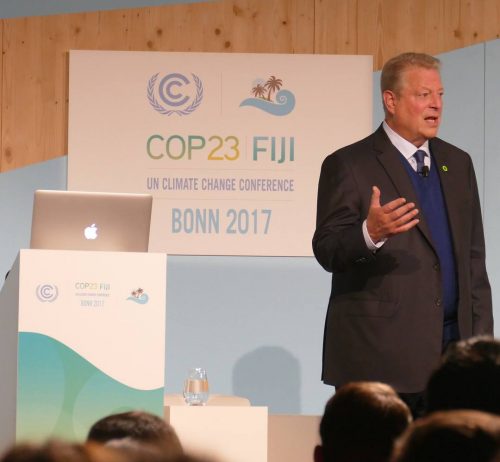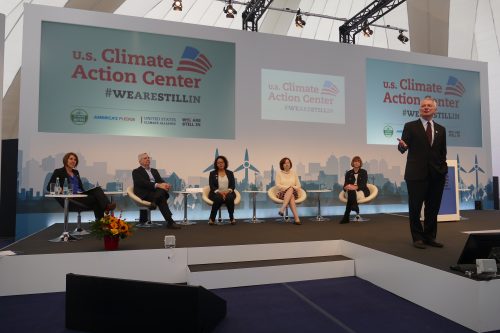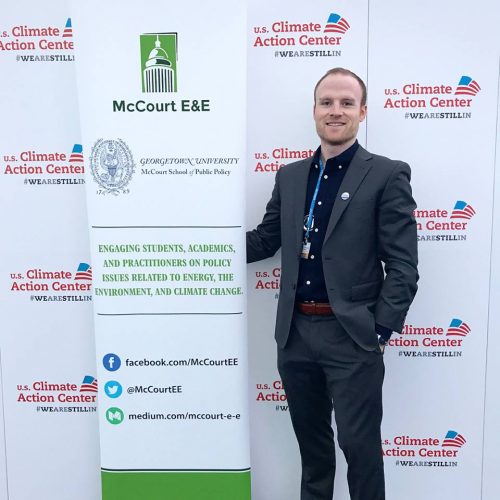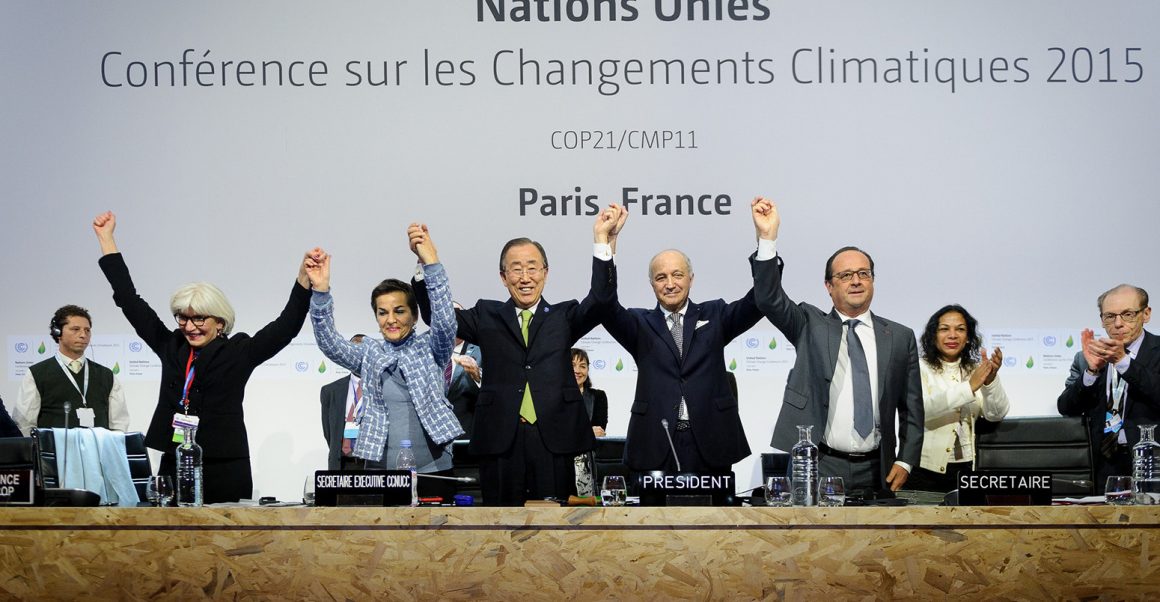Two years ago, the world came together in Paris to pass an international agreement that sought to limit the most disastrous effects of climate change. The historic nature of this “Paris Agreement” cannot be overstated. It took a long time for countries to agree climate change was a problem worth addressing and many failed attempts at turning that acknowledgment into something many diverse nations could agree to. Two years after Paris, every country on Earth has now signed the agreement and publicly pledged to reduce their greenhouse gas emissions to levels that would avert climate disaster. Unfortunately, progress by national governments in passing the necessary policies to actually meet their pledges has been slow. The rhetoric isn’t turning into reality and time is running out.
Weak commitments by national governments in meeting their Paris Agreement targets has led cities, states, and other “subnational actors” to take policymaking into their own hands in the fight against climate change. Last November’s United Nations climate conference in Bonn, Germany highlighted this geopolitical shift. As Vicki Arroyo, Executive Director of the Georgetown Climate Center and Professor from Practice at Georgetown Law, who has been to many negotiations over the years, put it to me, “this was the most important conference for subnational actors in the 25-year history of international climate negotiations.”
Professor Arroyo and the Georgetown Climate Center led a bipartisan delegation of 11 U.S. states, which included four governors, state legislators, and heads of state environmental and energy agencies to Bonn. It was the largest delegation of U.S. states to ever attend the annual climate talks. The Center and its partners also sponsored several side events at multiple venues. At one such event, the Center announced new developments in its “Transportation and Climate Initiative” with eight Northeastern and Mid-Atlantic states. The initiative will launch listening sessions to seek state-based policy solutions to “create the clean transportation system that the region needs to meet today’s and tomorrow’s challenges.” As Arroyo put it, “because of the presence of leading states, cities, and businesses, we were able to change the narrative despite the actions of the Trump Administration. The presence of subnational actors sent an inspiring message around the world that the U.S. is still committed. That made a big difference and is helping to move the process forward.”
I attended the conference as part of the Georgetown delegation that has been taking Georgetown faculty, students and state leaders to the climate talks since 2009. From Nov. 6 to 10, I saw the power of sub-national actors in standing up to national governments first-hand while representing the McCourt School of Public Policy. During my time at McCourt, I’ve specialized in energy, environmental, and climate change policy and have learned a great deal. But there is no substitute for attending these conferences where world leaders and diplomats from 195 countries come together with tens of thousands of “observers” like myself from academia, advocacy organizations, NGOs, and the private sector. November’s conference in Bonn was my third on behalf of Georgetown.

The conference framework provides a forum for discussion on reducing carbon emissions, adapting our infrastructure to the changing climate, unlocking private sector capital, deploying new technology, understanding the latest science, and everything in between. The goal is to limit the most severe effects of climate change on global society, and technical workshops, split up by issue area, advance this goal. When needed, new agreements are negotiated to set new frameworks and goals – like the Paris Agreement that committed all countries to work together to limit global warming to no more than two-degrees Celsius (2C) above pre-industrial levels by the end of this century. This technical process manifests as a 24/7, two-week whirlwind, with dozens of negotiations and countless side events occurring simultaneously each day (and sometimes late into the evening). It’s fun and torturous, fast-paced and boring, hope-filled and pessimistic, culturally immersive and insulated all at once. Each day ratchets up the adrenaline higher with so many reminders of what is at stake, the sense of urgency, and the impending doom if we do nothing.
It is now clear that the best-case-scenario policies every country put forward to reduce their greenhouse gas emissions under the Paris Agreement just two years ago would collectively result in three-degrees Celsius of warming or more by the end of the century. That blows past the targets of the Paris Agreement by at least a full degree to double the low-end 1.5C target. This latter target was included in the text of the agreement to reflect what might be the temperature point at which many small-island nations go under water. Indeed, with an observed global average warming of already 1.1C last year, we are already seeing rising sea levels threaten many islands and coastal regions. Doubling this effect is a big deal in global climate terms.
More aggressive plans to reduce carbon emissions are needed from all countries. In conference speeches I attended, diplomats openly admitted current plans are inadequate and called for them to be strengthened. Unfortunately, many of these same policymakers are not passing laws on the scale needed to close the gap within their own countries. No country — large or small, “developed” or “developing” — is exempt from weak commitments. Fossil fuel extraction for instance, as just one example of many to choose from, is still being subsidized around the world, including in the United States – which offers the industry a $700 billion annual subsidy, according to the IMF.
“This has to stop,” as Al Gore stated in an impassioned speech I attended on the topic. Ending fossil fuel subsidies is one path to increase renewable energy investment and reduce carbon emissions. Putting a price on carbon is another. Whatever the path, the time for action is now. If we continue on our current trajectory, emissions will continue to rise and lock us into a dangerous level of warming that will lead to climate disaster. These claims are supported by a wide body of research, including from the U.N.’s Intergovernmental Panel on Climate Change, the U.N. Environment Program, the World Bank, the International Energy Agency, and others. New research published in the journal Science, puts a finer point on the sense of urgency and concludes that, in order to meet the Paris Agreement’s goals, we must cap global greenhouse gas emissions within two years (by 2020) and fully decarbonize the entire world’s economy within just thirty years (by 2050). This will require the largest transformation of industry, society, technology, and economics in the shortest timeframe the world has ever seen.

Capping global emissions in just two years and fully decarbonizing the world’s economy within the next thirty is technically possible but politically, economically, and socially daunting. It’s not surprising that national governments have been slow to take the necessary steps. Nevertheless, it is the requirement of achieving sustainability. Fortunately, cities and states that will be most impacted by a changing climate have started to realize they must act. More than 90 percent of all urban areas are coastal, which means that they are on the front lines of rising sea levels, increased storm damage, and other impacts from climate change. These numbers come from the “C40 Cities Climate Leadership Group” (C40), which “connects 90 of the world’s greatest cities and represents 650+ million people / one-quarter of the global economy.” This group of Mayors has decided to do something about protecting their cities from the changing climate before it’s too late — and they’ve become influential. Through their collective economic power and population, they are able to pressure their respective national governments to do more to increase renewable energy investment, deploy smart transportation solutions, and pass stronger policies that reduce greenhouse gases.
This “bottom-up” approach to national climate policymaking may be just what is needed to achieve the Paris Agreement’s goals. Looking at the numbers, you get a sense why. Occupying only 2 percent of the world’s landmass, cities consume 70 percent of the world’s energy and account for roughly the same percentage of global, climate-changing CO2 emissions. The effect cities have on the climate will continue to grow as 67 million people move from rural to urban environments every year. Right now, half of the world’s population lives in cities but by 2050 that will grow to 70 percent. By 2030, the total urban population is expected to double from where it is now. That’s according to World Bank, International Energy Agency, UN-HABITAT agency, and others. Cities are also getting bigger. In 1950, there were 83 cities with more than 1 million people. Today, there are 400 cities with a population of more than 1 million, and 19 cities with over 10 million people. The era of the “megacity” is here and with it comes a mega-demand for power.
Mayors, Governors, and heads of multinational corporations with large carbon footprints do have a responsibility to act on combating climate change, and it’s heartening to see this recognition — as evidenced by the leadership of the Georgetown Climate Center delegation. In the United States, a broad coalition of governors, mayors, universities, faith-leaders, and businesses that represent more than half the entire U.S. economy and population has formed in order to achieve the U.S. policy goals under the Paris Agreement. They are the “We Are Still In” coalition and, if they were their own country, their economy would the third largest in the world.

The We Are Still In coalition set up their own United States Climate Action Center at the Bonn conference with non-stop events to highlight policies they are passing at the city, state, and corporate levels to incentivize clean energy production and reduce emissions. Republican Mayor of Carmel, Indiana Jim Brainard summed up the coalition’s sentiment as he addressed a packed crowd at the opening event of the US Climate Action Center on Nov. 9. “What I can tell you is that the United States is going to meet our Paris Agreement goals – with or without the federal government – cities and states are going to get it done. It’s important to point out to people from other countries that mayors and governors have a lot of power in the U.S. Just because the federal government isn’t acting, we can still act.”
When it comes to fighting climate change in the U.S. outside of Washington, California has no equal. For decades, California has set much higher standards for tailpipe emissions from cars and trucks than the federal government. These policies force auto manufacturers to comply if they wish to sell their product in the state (or the twelve other states that follow California’s standards), and have resulted in harmonized federal and state standards yielding a huge reduction of carbon emissions in the transportation sector. California emerged as a global climate leader with the passage of their Global Warming Solutions Act of 2006 that established a greenhouse gas cap-and-trade system. A number of subsequent state-level executive orders resulted in California’s statutory goal of an 80 percent reduction of emissions below 1990 levels by 2050. The vast majority of economists agree that putting a price on carbon is the most economical way to reduce carbon emissions. This policy is desperately needed at the federal level but has failed to pass.
In Bonn, California Governor Jerry Brown stated, “we can’t just wait for our national leaders—we need to take action together.” Governor Brown was appointed as the Special Advisor for states and regions before the climate conference because of his strong leadership at the state level. California is also part of a coalition of 205 jurisdictions (national and subnational) in 43 countries that collectively represent 1.3 billion people and $30 trillion in GDP known as the Under2 coalition. Each signatory in the coalition is committed to reducing their economy-wide emissions to 80-95 percent below 1990 levels, or below 2 annual metric tons per capita, by 2050 — which, again, is consistent with the goals of the Paris Agreement outlined previously in this article. As Arroyo from the Georgetown Climate Center mentioned, it is inspiring to see such leadership from subnational actors around the world.

Two things are clear to me after attending the recent conference. First, the tides are turning, the world is starting to move in the right direction, and there is no question carbon emissions will be reduced over time as we enter our third industrial revolution – the clean energy revolution. However, as I wrote for the Georgetown Public Policy Review after attending last year’s U.N. climate conference in Morocco, “time is our greatest enemy in the fight against climate change. Can we decarbonize the world economy in time to avoid the worst climate impacts?” While progress is being made and subnational actors are stepping up, this question remains and grows more urgent each year.
Second, subnational actors have the will to pass policies to combat climate change — given that many of them are on the frontlines — even if their respective national governments do not. The pressure that cities, states, corporations, NGOs, and other non-national actors can exert to ensure national governments do the right thing for our future is powerful. Exerting relentless pressure on governments and the private sector to move in the right direction is the only way we will achieve the Paris Agreement and avert climate disaster. Large institutions do not do well with rapid change but that does not mean it’s impossible. As we have seen with many other movements in this country, such as the recent movement for same-sex marriage and equality, cities and states can be the laboratories of democracy that lead to nation-wide action.
Year after year, alarm bells are rung by the scientific, academic, and civil society communities that time is running out in ensuring our future remains sustainable against the threat of global climate change. Any backsliding due to politics threatens this narrow window. Yet, these are the real-world challenges international agreements of any kind face. The framework of the annual U.N. climate conferences is supposed to enable the international community to move forward in the face of any individual country’s periodic turbulence. That framework is currently being put to the test but there are points of optimism. As international politics play out in real time, we must remember there is a total cap on the amount of carbon we can emit into the atmosphere before we irreversibly push the climate beyond its breaking point. The next two years may direct the fate of the next few generations and the policies passed by subnational actors may be the deciding factor in whether or not that fate is something to look forward to.
Will Hackman is third-year, part-time MPP student specializing in energy, environmental, and climate change policy. Will founded a graduate student organization at McCourt dedicated to developing energy, environmental, and climate change policy solutions (McCourt E&E), he served as the 2016-2017 graduate student representative to the Steering Committee of the Georgetown Environment Initiative, as a Research Assistant to the Georgetown Climate Center, directed the Young Professionals Board of the Sustainable Oceans Alliance, represented Georgetown at multiple United Nations climate change conferences overseas, and is a contributing author on energy, environmental, and climate change topics for a variety of campus publications including the Georgetown Public Policy Review and SFS’s Journal of International Affairs. This academic year, Will has been selected to serve as a Student Leader to the McDonough School of Business’s Global Social Enterprise Initiative.

The Strategic Environment, Planning & Transport Committee (SEPT) of Reading Borough Refuse to Declare Emergency over Climate Change GHG Emissions
I have made a representation to Reading’s “New local Plan” 2018-36 to take emergency action to prevent the catastrophic impacts of man-made hazards. The SEPT has since the outsourced Reading Climate Change Strategy 2013-20 took place refused stating:
“The ambitious target that the Council has set for the whole Borough in its original climate change strategy has been further extended to aim for Reading to be 100% run on clean energy by 2050.”
“We await the development of policies and regulations that will allow us to meet our objectives. Councils are not bound to meet any obligations that are not set in UK statue. We do not report directly to the UN on Climate Change, we report our progress to our local residents in accordance with our constitution.” ~Signed the Deputy Leader of the Council and Lead Councillor for SEPT
“There is no requirement for a separate risk assessment”
These blunt statements clearly show lack of will to tackle the problems of our changing climate, therefore should be challenged if local leader in post fit for purpose.
By declining international binding agreements on any level is a significant risk of irreversible damage as all the signs of coming damage from our changing climate are fast approaching.
The position of the SEPT committee is an unfair acquiescence. The New Local Plan (Reading Borough Council will not be able to accept representations made after Friday 26th January 2018) has in effect without specific reference to one all-encompassing cause, refused to consider the seriousness and span of issues we raise in our representation for action on man-made hazards. I’m afraid the in the consultation on the New Local Plan does not have a risk-impact assessment in place, this will affect all Readinger’s work/life balance for the next 18 years…
Further the refusal to precede catastrophic near future with urban leadership not only promotes local governments to proceed with significant risk but also delays action to prevent some unwanted change the principle that preventive action should be taken to avert environmental damage; delays action in a way that undermines the very science of climate change and our representation for action.
Goal 13: Take urgent action to combat climate change and its impacts
Goal 11: Make cities open, inclusive, resilient and sustainable
One year ago, the SEPT was strongly advised to revise and provide adequate resources to plan for urban action adapting to our changing climate. The New Local Plan shows climate ignorance without any future ambition or vision.
If non-ambitious climate risk/impact action is taken in response to our representation to Reading’s Town Plan, Reading’s new urban development agenda (the NLP) will not be legally compliant with the national targets within the Paris Agreement, Climate-Illegal* etc.
*To actively promote the continuing emission of carbon gases into the atmosphere with full knowledge of the consequences, including the breakdown of the large ice sheets, sea level rise and intensification of extreme weather events such as hurricanes and fires around the world.
Reading Borough Council (RBC) needs to fast track actions now towards a 100% sustainable Reading. The plotting System of land and Planning Applications in the New Local Plan must have mitigation/adaptation (M,A) and ecological consent.
The emission budgets required to prevent dangerous climate change is a potentially irreversible and requires an extreme emergency process in which all stakeholders on a local level must also partake.
Secure a safer city in Reading’s New Local Plan
Please see our final representation on Urban Resilience delivered to Reading Borough Council as per link, http://tvb-climatechallenge.org.uk/wp-content/uploads/2018/01/ClimateChangeCentreReading-RBC-Planning-Policy-Team_A-representation-about-the-New-Local-Plan.pdf
It is applicable to small to medium cities in the UK. Protection of People and Assets in Berkshire, Oxfordshire, Buckinghamshire etc…
Every council’s planning committees casting plans way ahead of the next World Habitat Conference 2036. From no to very poor risk evaluation it is unsafe and unhealthy to take further steps. It is also proven that a genuine risk assessment will save two thirds of the costs instead of doing it after planning permission. Looking at this globally, you might save £££ in any other cases, the point really is that investing in resilience always pays.
The purpose with this Representation/Objection is via policy innovation and risk/protection impact evaluation, to improve Reading’s local urban development practices and planning, to support the British realm and ambitions to become a great global leader in the fight against global warming.
#wuf9kl #wuf9 #ConvenantofMayors #Investment #Climatefinance #EGCA #NewLocalPlan – #climatechange #ParisAgreement #SDGs #UK
The representation a must read for anyone who understands the facts about urban resilience. /Kindly support our way to future proof urban development in the UK.
Please don’t ignore this important article and share with your local council and distribute as widely as possible. This is a very important objection to urban development planning and with support it is just possible that we will get more reaction.
Every weekend i used to pay a quick visit
this web page, as i want enjoyment, as this this web page conations really pleasant funny data too.